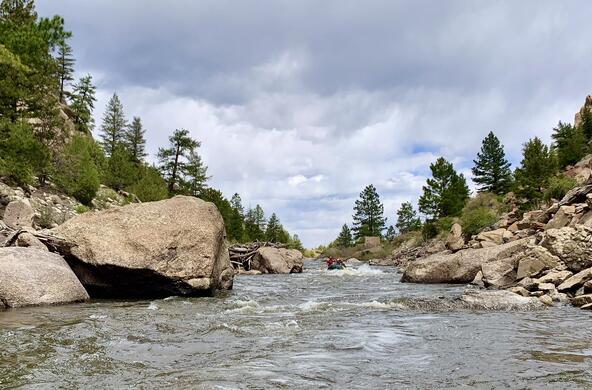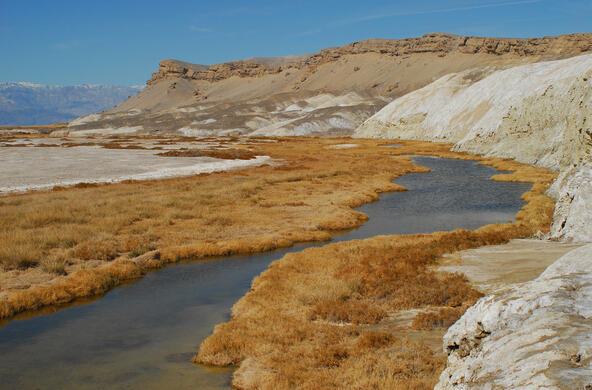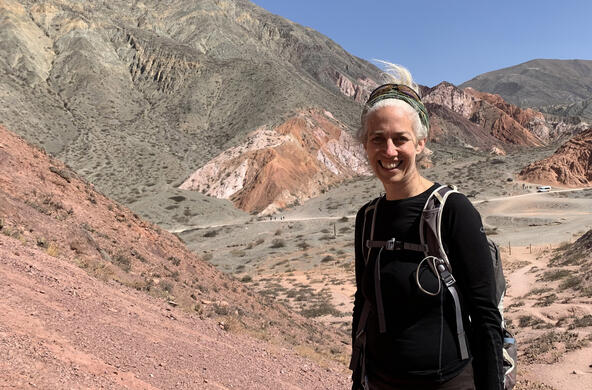When certain oxidized gases, such as sulfur dioxide (SO2) and nitrogen dioxide (NO2), dissolve in water, they make it acid. When these gases are emitted as air pollutants, they cause acid rain in the regions downwind of the source. The rain that falls is a weak solution of sulfuric and nitric acids—albeit less acid in recent years as the Clean Air Act has reduced air pollution.
Chemists describe the acidity of water using a convention known as pH. Waters that are neutral have a pH of 7.0. Acid waters have lower pH, though most natural waters are seldom lower than 4.0. Acid rain can have a pH as low as 3.0.
In the atmosphere, when carbon dioxide dissolves in water, it forms carbonic acid, which lowers the pH from 7.0 to about 5.7. The pH of water in equilibrium with higher levels of carbon dioxide is even lower—2.5 for Coca Cola and about 4.0 for beer—due to artificial injection of carbon dioxide into these drinks, which is emitted as bubbles of gas when we open one.
Alkaline waters have a pH above 7.0. When I first entered this field, marine chemists reported the pH of seawater as 8.3.
Even if you are one of the dwindling few who do not believe that rising levels of carbon dioxide in the atmosphere will cause global climate change, it will be hard to dismiss the record of acidification of the oceans caused by the increasing carbon dioxide dissolved in them. The pH of seawater in the central North Pacific Ocean has dropped from 8.2 to about 8.05 during the past 50 years, in mirror image to the rise of carbon dioxide in the atmosphere. The pH has fallen at a rate of 0.06 per year during the past 15 years.
You may ask: the pH above 7.0 is still alkaline, so why should you care? First, if you enjoy shellfish, like oysters, mussels and clams, it is worth noting that many of these species are unable to form their carbonate shells as pH drops below 7.5. The carbonate skeletons of corals are even more vulnerable. Thus, the rising carbon dioxide content of Earth’s atmosphere will take an increasing toll on the shellfish and corals of the seas.
Most of us are not familiar with coccolithophores, which are microscopic phytoplankton with carbonate shells that are responsible for a large portion of the photosynthesis in the oceans. As seawater acidifies, increasingly, some of these species will be unable to form their carbonate shells. Some species are more susceptible than others, so ocean acidification is likely to affect the species composition of the phytoplankton community. Unless they are replaced by more resistant species, the loss of coccolithophores would lower the overall productivity of the oceans. And, of course, what happens to photosynthesis determines how much energy is available to move up the food chain to the marine fisheries that are increasingly important to us as a source of protein.
Ocean acidification is the dark side of rising carbon dioxide in Earth’s atmosphere. It is perhaps easy to overlook, but hard to dismiss its dire consequences.
References
Dodd, L.F., J.H. Grabowski, M.F. Piehler, I. Westfield, and J.B. Ries. 2021. Juvenile eastern oysters more resilient to extreme ocean acidification than their mud crab predators. Geochemistry, Geophysics and Geosystems https://doi.org/10.1029/2020GC009180
Doney, S. C., D. S. Busch, S.R. Cooley, and K.J. Kroeker. 2020. The impacts of ocean acidification on marine ecosystems and reliant human communities. Annual Review of Environment and Resources 45: 83-112.
Dore, J.E., R. Lukas, D.W. Sadler, M.J. Church, and D.M. Karl. 2009. Physical and biogeochemical modulation of ocean acidification in the Central North Pacific. Proceedings of the National Academy of Sciences 106: 12235-12240.
Harvey, B. P., K. Kon, S. Agostini, S. Wada, & J.M. Hall‐Spencer. 2021. Ocean acidification locks algal communities in a species‐poor early successional stage. Global Change Biology https://doi.org/10.1111/gcb.15455
Klepas, J.A. and K.K. Yates. 2009. Coral reefs and ocean acidification. Oceanography 22: 108-117.
Meyer, J. and U. Riebesell. 2015. Reviews and syntheses: Responses of coccolithophores to ocean acidification: A meta-analysis. Biogeosciences 12: 1671-1682.
Riebesell, U., L. Zondervan, B. Rost, P.D. Tortell, R.E. Zeebe, and F.M. Morel. 2000. Reduced calcification of marine plankton in response to increased atmospheric CO2. Nature 407: 364-367.








